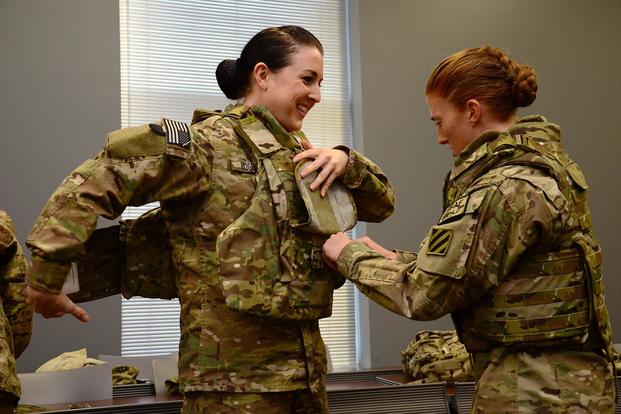The services have to speed up the process of getting body armor fitted for female troops into the field, Joint Chiefs Chairman Gen. Joseph Dunford said.
"We knew it would take some time" to deliver specially fitted body armor, particularly in smaller sizes, to accommodate women once then-Defense Secretary Ashton Carter opened up all combat billets to women in 2016, Dunford told the Senate Defense Appropriations subcommittee last week.
"We knew in 2016 that the standard equipment -- particularly as women began to occupy fields where they hadn't historically been and they were wearing combat armor, packs, those kinds of things [that] had been built for the average male and not the average female -- that we would have to adjust that," he explained.
Dunford said each of the services is working to make changes in the standard sizes of body armor. "It is taking some time, but I can assure you they are all attentive to it," he said in response to questions from Sen. Lisa Murkowski, R-Alaska.
"We've seen the integration of women into the front lines," Murkowski said, but "equipment requirements for women are lagging. Currently, only the Army has women-specific body armor, but quantities are so low that I understand it's only issued to women who are deploying and not during any initial entry or unit training."
The initial efforts in 2016 to come up with better fitting body armor, and also lighten the equipment load, were led by then-Lt. Gen. Michael Williamson, now retired, who was military deputy to the assistant secretary of the Army for acquisition, logistics and technology.
"We've added eight additional sizes, based on a better understanding of the stature" of soldiers, both male and female, Williamson told a subcommittee of the House Armed Services Committee in March 2016.
"It's not just being smaller, it's proportions" when it comes to women soldiers, he said. "That's why there are so many additional sizes. Anybody who has worn a piece of body armor knows it's inconvenient enough without being able to appropriately size it."
"We approach the soldier protection system from the level that we always want to find ways to improve its capability but also lighten the load -- whether you are talking about the protective vest or you are talking about the helmet," Williamson said.
He said the weight problem is gender neutral. "It has nothing to do with whether you are a male or female. We can't burden our soldiers with more weight."
The military recently also began addressing an additional problem for women troops: accommodating protective equipment for longer hair.
As reported by Military.com, recent presentations by the Army and the Marine Corps for the Pentagon's Defense Advisory Committee on Women in the Services included changes to ensure gear fits correctly for women with hair buns.
At a presentation in March, Army Lt. Col. Ginger L. Whitehead, product manager for Soldier Protective Equipment, showed a new version of the Female Improved Outer Tactical Vest, or FIOTV, that includes a yoke-and-collar assembly that dips in the back to accommodate a hair bun, along with other fit improvements to offer better ballistic protection for women.
-- Richard Sisk can be reached at Richard.Sisk@Military.com.










